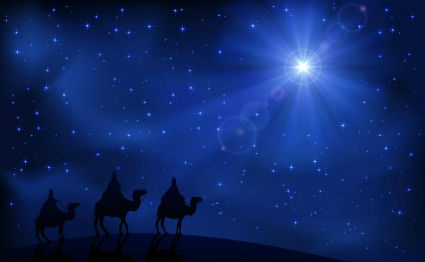Star of Bethlehem

Three factors must be considered in any investigation of the star of Bethlehem. In order of precedence they are the text of Matthew's gospel, the magi themselves, and plausible astronomical phenomena. These considerations are related to several chronological puzzles, including the precise year of Christ's birth. Most historians place Christ's nativity around 5 BC, no later than Herod's death after a lunar eclipse in the spring of 4 BC.
Perhaps the star was miraculous, a manifestation of the "sons of the morning" (cf. Job 38:7). Matthew's curious description of the star "going before" the magi and "standing over" Bethlehem has prompted writers from John Chrysostom (fourth century) to Bernard Ramm (twentieth century) to regard the star as an angelic or supernatural phenomenon. Yet Matthew does not explicitly associate the star with direct angelic guidance. The magi's interpretation of the star according to their own wisdom led them to Jerusalem; Herod sent them to Bethlehem on the basis of Micah's prophecy (Mic. 5:2).
With respect to the magi, Matthew affirms neither that they were kings nor that they were three in number. According to Matthew, they came not from the Roman Empire, but from the east. Babylon at this time was the leading center for magi who were not only astrologers but also proficient astronomers. Babylonian magi were historical, not legendary, and their astronomical knowledge was sophisticated, not trivial. These magi, the "scribes of Enuma Anu Enlil," pioneered quantitative methods in ancient astronomy and could predict planetary cycles hundreds of years into the future (Swerdlow 1998). Few discussions of the Bethlehem star appreciate the capability of mathematical astronomy in this cuneiform tradition or delve deeply into the historical question of the magi's astrology, that is, how they interpreted celestial events.
In addition to the astronomy and astrology of the magi, because of the presence of a Jewish community in Babylon from the time of the exile, the magi may also have been familiar with Jewish prophecies of a coming Messiah. A chief concern of the magi was to advise the king on the rise and fall of empires. The book of Daniel, which refers to Daniel as head over the magi (e.g., Dan. 2:48; 5:11), accurately reflects this preoccupation while countering that the God of heaven, not the stars themselves, gives dominion. Daniel's vision of the Ancient of Days may describe the one whom the magi were seeking. Unlike the long succession of Mesopotamian kingdoms, the Messiah's kingdom would never be destroyed, and all nations of the world would worship him. When this everlasting kingdom arrives, divination by the stars—the way of life of the magi—would pass away. Indeed, the astronomical cuneiform tradition died out in the first century AD, only a few generations after the journey to Bethlehem.
With respect to astronomy, study of the star offers an engaging prospect, for at one time or another, practically every astronomical phenomenon has been proposed. We may group the multitude of theories according to whether they regard the star as an unexpected source of bright light or as a familiar planet moving into a significant configuration during the course of its planetary cycle.
In the first group are explanations of the star as a nova, supernova, or comet. Many have imagined the star shining brightly in the sky, from Ignatius (late first century) to nativity depictions by Albrecht Diirer (sixteenth century) or Longfellow's poem "The Three Kings" (nineteenth century). Others have invoked comets to provide a commonsense explanation of how the star "stood over" the horizon of Bethlehem, from Origen (third century) to Giotto's painting The Adoration of the Magi (fourteenth century). Chinese records do confirm the appearance of what was either a nova or a comet in 5 BC, although ancient observers left no record of a bright star or supernova at this time. Colin Nicholl (2015) argues that the star was a different, unrecorded comet on the basis of scriptural evidence, including Revelation 12.
In the second group are explanations in which the star or
"aster" refers to a planet in a significant configuration according
to ancient astrology. These interpretations associate the
star with the heliacal rising and retrograde motion of Jupiter,
the regal planet. Matthew 2:2 and 2:9 (NASB) refer to the
star "in the east," which an astronomer would understand
as its heliacal rising on the eastern horizon moments before
sunrise. A heliacal rising is the first appearance of a star or
planet in the morning sky, just ahead of the sun, after a
period of invisibility in the daytime sky. Heliacal risings
were associated with birth,
During retrograde motion, a planet briefly reverses its usual eastward direction and appears to travel westward against the background of fixed stars. In other words, during retrograde motion, a planet moves faster westward than, or goes before, the nightly westward motion of the stars. Planets also appear brightest while retrograding. Matthew's description of the star standing over" refers, in astronomical terms, to a planet's "stationary point" at the beginning or end of retrograde motion, when a planet appears to be fixed in place against the background stars. Because these planetary events are not visually striking to a casual observer, it is not surprising that Herod's court failed to notice the star, nor that Matthew s account seems confusing to readers unfamiliar with the apparent motions of the planets.
Consider the remarkable motion of the regal planet Jupiter around the time of the birth of Christ. Jupiter completed at least two interesting episodes of heliacal rising followed by retrograde motion.
The first episode, which occurred in Pisces, began with Jupiter s heliacal rising in March 7 BC. Jupiter, moving more quickly than Saturn, passed Saturn in May, making a conjunction. Conjunction refers to the sharing of the same coordinate with respect to the ecliptic or path of the sun (whether the two planets are in close visual proximity or appear to fuse is irrelevant). Jupiter reached its first stationary point in July, after which it began a period of retrograde motion. Jupiter then passed Saturn again in October to make a second conjunction. In November Jupiter reached its second stationary point, when its retrograde motion ended and it resumed its ordinary eastward motion. In December it passed Saturn a third time, completing a rare "triple conjunction" of a sort that recurs only every 800 years. A triple conjunction occurs when one planet passes by another three times in succession before, during, and after its retrograde loop. After this triple conjunction in January 6 BC, the two planets were joined by Mars, and then Jupiter disappeared into the daytime sky (Parpola 2001).
The Babylonian magi were deeply interested in these events and capable of predicting them. Indeed, Jupiter's stationary points and retrograde motion during the triple conjunction with Saturn in 7 BC are attested by four extant cuneiform tablets. These tablets are almanacs, which do not document how the magi interpreted the events, however (Sachs 1984). Later Rabbi Isaac Abarbanel (fifteenth century), who drew upon the astrology of Masha'allah (eighth century), attested in a commentary on the book of Daniel that triple conjunctions in Pisces were associated in Jewish tradition with the advents of Moses and the Messiah.
 Johannes Kepler
Johannes KeplerJohannes Kepler is the best-known exemplar of triple conjunction interpretations, although his scenario culminates with a bright star. What is now known as Kepler's supernova appeared in 1604. It followed a triple conjunction of Jupiter and Saturn in 1603 and a planetary association of Jupiter, Saturn, and Mars in 1604. Impressed by this sequence, Kepler discovered the triple conjunction in Pisces of Jupiter and Saturn in 7 BC, followed by the gathering with Mars, as noted above. Kepler then postulated that the ancient sequence would also have led to a bright star, the star of Bethlehem, as a counterpart to the supernova witnessed in 1604 (Kepler, De Stella nova, 1606; repeated in Kepler, De anno natali Christi, 1614). Kepler's proposal is often adopted in popular Christmas planetarium programs. Numerous writers throughout the nineteenth and twentieth centuries have favored it, with some variations (Hughes, Kidger, Ferrari-D'Occhieppo, Parpola).
The second episode, which occurred in Aries, began with Jupiter's heliacal rising on April 17, 6 BC, with other planets in auspicious positions. On the same day, it was occulted by the moon. Jupiter then entered another period of retrograde motion between its first stationary point in August and its second stationary point in December 6 BC. Molnar demonstrates that according to Roman astrology, the planetary configuration on April 17, 6 BC, heralded an unconquerable king of the universe born in Judea. With Mercury, Venus, Mars, and Saturn auspiciously positioned, the horoscope for this date was superior to Augustus Caesar's (Molnar 1999). On this scenario, Matthew 2:2 and 2.9 refer to the heliacal rising and retrograde motion of 6 BC, rather than the heliacal rising and triple conjunction with Saturn in 7 BC.
Consequently, explanations of the star as a planetary astronomical event involving Jupiter's motion in Pisces in 7 BC or in Aries in 6 BC, which the magi interpreted as foretelling the birth of a Jewish Messiah, appear consistent with what is currently known of the magi.
The potential viability of several candidates for the star renders skepticism toward the historicity of Matthew's story unnecessary. Yet the nature and identity of the star must remain an open question at least until the magi and their ancient cuneiform tradition of mathematical astrology are better understood.
– Kerry Magruder
References and Recommended Reading
Barthel, Peter, and George Van Kooten, eds. 2015. The Star of Bethlehem and the Magi: Interdisciplinary Perspectives from Experts on the Ancient Near East, the Greco-Roman World, and Modern Astronomy. Leiden: Brill.
FerrariD'Occhieppo, Konradin. 1989. "Star of the Magi and Babylonian Astronomy." In Chronos, Kairos, Christos. Eds. Jerry Vardaman and Edwin M. Yamauchi, 41-54. Winona Lake, IN: Eisenbrauns.
Hughes, David. 1979. The Star of Bethlehem: An Astronomer's Confirmation. New York: Walker.
Kidger, Mark. 1999. The Star of Bethlehem: An Astronomer's View. Princeton, NJ: Princeton University Press.
Molnar, Michael. 1999. The Star of Bethlehem: The Legacy of the Magi. New Brunswick, NJ: Rutgers University Press.
Nicholl, Colin R. 2015. The Great Christ Comet: Revealing the True Star of Bethlehem. Wheaton, IL: Crossway.
Parpola, Simo. 2001. "The Magi and the Star: Babylonian Astronomy Dates Jesus' Birth." Bible Review 17:17-23, 52-54.
Ptolemy. 1940. Tetrabiblos. Trans. Frank E. Robbins. Loeb Classical Library. Cambridge, MA: Harvard University Press.
Sachs, Abraham J., and C. B. F. Walker. 1984. "Kepler's View of the Star of Bethlehem and the Babylonian Almanac for 7/6 B.C." Iraq 46:43-55.
Swerdlow, Noel. 1998. The Babylonian Theory of the Planets. Princeton, NJ: Princeton University Press.
This entry appeared in the Dictionary of Christianity and Science edited by Paul Copan, Tremper Longman III, Christopher L. Reese, Michael Strauss (Zondervan, 2017).
Also by Kerry Magruder:
Christmas reflections – magi